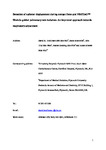Identification of deliberate catheter motion at the left atrial posterior wall during pulmonary vein isolation: Validity of respiratory motion adjustment
| dc.contributor.author | Tomlinson, DR | |
| dc.contributor.author | Biscombe, K | |
| dc.contributor.author | True, J | |
| dc.contributor.author | Hosking, Joanne | |
| dc.contributor.author | Streeter, Adam | |
| dc.date.accessioned | 2021-11-24T17:09:14Z | |
| dc.date.issued | 2021-04 | |
| dc.identifier.issn | 1045-3873 | |
| dc.identifier.issn | 1540-8167 | |
| dc.identifier.uri | http://hdl.handle.net/10026.1/18409 | |
| dc.description.abstract |
<jats:title>Abstract</jats:title><jats:sec><jats:title>Background</jats:title><jats:p>During automated radiofrequency (RF) annotation‐guided pulmonary vein isolation (PVI), respiratory motion adjustment (RMA) is recommended, yet lacks in vivo validation.</jats:p></jats:sec><jats:sec><jats:title>Methods</jats:title><jats:p>Following contact force (CF) PVI (continuous RF, 30 W) using general anesthesia and automated RF annotation‐guidance (VISITAG™: force‐over‐time 100% minimum 1 g; 2 mm position stability; ACCURESP™ RMA “off”) in 25 patients, we retrospectively examined RMA settings “on” versus “off” at the left atrial posterior wall (LAPW).</jats:p></jats:sec><jats:sec><jats:title>Results</jats:title><jats:p>Respiratory motion detection occurred in eight, permitting offline retrospective comparison of RMA settings. Significant differences in LAPW RF auto‐annotation occurred according to RMA setting, with curves displaying catheter position, CF and impedance data indicating “best‐fit” for catheter motion detection using RMA “off.” Comparing RMA “on” versus “off,” respectively: total annotated sites, 82 versus 98; median RF duration per‐site, 13.3 versus 10.6 s (<jats:italic>p</jats:italic> < 0.0001); median force time integral 177 versus 130 gs (<jats:italic>p</jats:italic> = 0.0002); mean inter‐tag distance (ITD), 6.0 versus 4.8 mm (<jats:italic>p</jats:italic> = 0.002). Considering LAPW annotated site 1‐to‐2 transitions resulting from deliberate catheter movement, 3 concurrent with inadvertent 0 g CF demonstrated < 0.6 s difference in RF duration. However, 13 deliberate catheter movements during constant tissue contact (ITD range: 2.1–7.0 mm) demonstrated (mean) site‐1 RF duration difference 3.7 s (range: −1.3 to 11.3 s): considering multiple measures of catheter position instability, the appropriate indication of deliberate catheter motion occurred with RMA “off” in all.</jats:p></jats:sec><jats:sec><jats:title>Conclusions</jats:title><jats:p>ACCURESP™ respiratory motion adjustment importantly delayed the identification of deliberate and clinically relevant catheter motion during LAPW RF delivery, rendering auto‐annotated RF display invalid. Operators seeking greater accuracy during auto‐annotated RF delivery should avoid RMA use.</jats:p></jats:sec> | |
| dc.format.extent | 994-1004 | |
| dc.format.medium | Print-Electronic | |
| dc.language | en | |
| dc.language.iso | en | |
| dc.publisher | Wiley | |
| dc.subject | atrial fibrillation | |
| dc.subject | automated radiofrequency annotation | |
| dc.subject | contact force catheter ablation | |
| dc.subject | pulmonary vein isolation | |
| dc.subject | respiratory motion adjustment | |
| dc.title | Identification of deliberate catheter motion at the left atrial posterior wall during pulmonary vein isolation: Validity of respiratory motion adjustment | |
| dc.type | journal-article | |
| dc.type | Journal Article | |
| dc.type | Research Support, Non-U.S. Gov't | |
| plymouth.author-url | https://www.webofscience.com/api/gateway?GWVersion=2&SrcApp=PARTNER_APP&SrcAuth=LinksAMR&KeyUT=WOS:000620193600001&DestLinkType=FullRecord&DestApp=ALL_WOS&UsrCustomerID=11bb513d99f797142bcfeffcc58ea008 | |
| plymouth.issue | 4 | |
| plymouth.volume | 32 | |
| plymouth.publication-status | Published | |
| plymouth.journal | Journal of Cardiovascular Electrophysiology | |
| dc.identifier.doi | 10.1111/jce.14945 | |
| plymouth.organisational-group | /Plymouth | |
| plymouth.organisational-group | /Plymouth/Faculty of Health | |
| plymouth.organisational-group | /Plymouth/REF 2021 Researchers by UoA | |
| plymouth.organisational-group | /Plymouth/REF 2021 Researchers by UoA/UoA03 Allied Health Professions, Dentistry, Nursing and Pharmacy | |
| plymouth.organisational-group | /Plymouth/Research Groups | |
| plymouth.organisational-group | /Plymouth/Research Groups/Institute of Health and Community | |
| plymouth.organisational-group | /Plymouth/Research Groups/Institute of Translational and Stratified Medicine (ITSMED) | |
| plymouth.organisational-group | /Plymouth/Research Groups/Institute of Translational and Stratified Medicine (ITSMED)/CBBB | |
| plymouth.organisational-group | /Plymouth/Research Groups/Plymouth Institute of Health and Care Research (PIHR) | |
| plymouth.organisational-group | /Plymouth/Users by role | |
| plymouth.organisational-group | /Plymouth/Users by role/Academics | |
| dc.publisher.place | United States | |
| dcterms.dateAccepted | 2021-02-07 | |
| dc.rights.embargodate | 2022-2-22 | |
| dc.identifier.eissn | 1540-8167 | |
| dc.rights.embargoperiod | Not known | |
| rioxxterms.versionofrecord | 10.1111/jce.14945 | |
| rioxxterms.licenseref.uri | http://www.rioxx.net/licenses/all-rights-reserved | |
| rioxxterms.licenseref.startdate | 2021-04 | |
| rioxxterms.type | Journal Article/Review |


